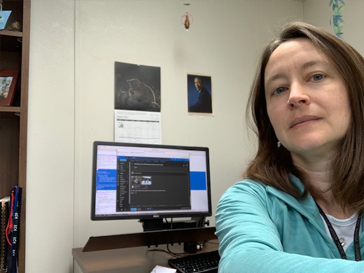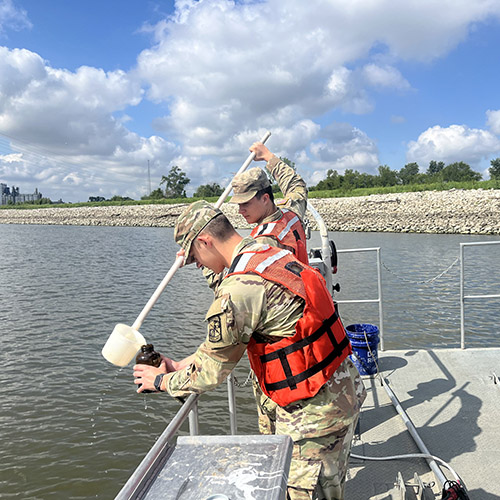Russell Named as FNR Distinguished Alumna
Growing up in suburbs of Long Island, New York, Robin Russell enjoyed going to the beach at low tide and digging around in the mud flats looking for snails and fish. She loved animals and she loved going to the national parks.Like many children, initially she wanted to be a veterinarian, but as she got older, she became more interested in pursuing a career in science and asking questions. The result: a career in wildlife ecology, one that combined her love of animals and the outdoors.
Russell’s journey into wildlife ecology began at Reed College in Portland, Oregon, where she earned her bachelor’s degree in biology in 1995. She received her master’s degree in zoology from Colorado State University in 1999 and completed her academic journey in 2003 with a PhD at Purdue, after studying small mammals and connectivity questions under Dr. Rob Swihart.
“I worked on modeling, so I did a lot of computer work back then,” Russell recalled. “For a while they had a little plaque above the computer that I worked on that said ‘For people who find simulating stimulating’ or something like that. I also put little collars out on voles and we built enclosures out at the wildlife preserve where Mickey Weeks lived and tracked them around looking at difference in movement rates between different types of landscapes. Then we built that up into the larger model.”
After graduation, Russell went to work as a quantitative ecologist for the U.S. Forest Service, first as a post-doctoral researcher for two years through the department of ecology at Montana State University, then she was hired full time to remain at the Rocky Mountain Research Station in Bozeman, Montana, for two more years. Russell then took a position as a biometrician for the Montana Fish, Wildlife and Parks Service in the same location for two years.
For the past 10 years, Russell has returned to her roots, building simulation models as a research statistician for the U.S. Geological Survey National Wildlife Health Center in Madison, Wisconsin. Russell’s models look at the effects of disease and vaccination on wildlife in order to help people make decisions about how to manage them
“In layman’s terms, I look at developing new ways to analyze wildlife data in order to provide better inferences and I develop models to assess the effects of disease or management practices on wildlife. The main focus of my work is modeling and statistics. What is great about being a qualitative ecologist is that you get to play in other people’s backyards. I’ve worked on a lot of different species from frogs to mammals and more. It’s a great skill set to have because it is applicable across a broad range of opportunities. You can jump in where needed.”
Russell counts prairie dogs, voles, squirrels, wolves, bats, bison, bald eagles, ducks and deer among the species she has studied. She also has looked into the effects of prescribed fire on avian species and squirrels. Russell credits many of her classes in Forestry and Natural Resources at Purdue for preparing her for a career in qualitative ecology.
“The population dynamics class that Rob Swihart taught was very useful,” Russell said. “I also took a good course, a discussion class on dispersal, with Peter Waser in the biology department. I took a science communications class from David Case, and at the time I didn’t appreciate how useful it was. It is really important especially if you’re in a senior scientist position to be able to communicate with people about your science and do it in the right way so they can understand you. The only way your science is going to get used is if you are able to communicate.”
In the process of her research, Russell has developed analytical tools that have led to a broader understanding of the links between environmental processes and wildlife disease dynamics.
“One of the questions that we always deal with in wildlife disease when a disease first emerges is where is it going to go next; where can we tell people to look that is a high-risk area,” Russell explained. “We’ve been working with some colleagues on developing diffusion models that are applicable across multiple systems. We’ve used it for chronic wasting disease and for white nose syndrome, and now we are looking at the rabbit hemorrhagic disease virus. These models can help us understand the factors that are influencing the growth and spread of the disease and then they can help us identify areas where the disease might emerge next so we can send people to go look for it in focused surveillance efforts.
“Disease is hard, because there are not too many management options, but it is personally satisfying to work with people and try to help them work through a management problem. Do we vaccinate or do we try to prevent movement of a disease? Our hope is to develop a framework for when diseases first emerge, so that we can do something quickly rather than waiting four to 10 years to develop a management plan for an emerging disease. The only way to really keep wildlife around is to make sure they have resilient populations that are able to withstand the impacts of disease and other stressors.”
In more than 74 publications and 68 peer reviewed journal articles and three book chapters, Russell has examined disease dynamics and evaluated wildlife health to inform fellow ecologists, government agencies and wildlife managers about everything from the effects of prescribed burns on woodpeckers, cavity nesting birds and squirrels, to wolf population dynamics, to strategies to fight avian influenza and how to incorporate spatial structure into models of plague transmission.
“The work that might have the most impact is not necessarily the papers that have the most citations,” Russell shared. “Things like working with the state of Montana to help them develop their surveillance program to look for chronic wasting disease, or the white-nose surveillance efforts for bats which allowed us to identify the areas where the disease showed up the next year, or what I am doing right now with some endangered rabbit species with RCV-2 (rabbit hemorrhagic disease virus type 2) to try to provide guidance on using models on what their vaccination rates need to be to help combat those disease … those thing may not be the most exciting science or papers, but they are personally satisfying. Those are the things I enjoy the most, being able to see that science in action.”
Russell’s work has drawn in grants from agencies ranging from the National Science Foundation to the Department of Defense’s Strategic Environmental Research and Development Program and has included international collaborations as well.
In 2020, Russell shared her data synthesis techniques in a presentation entitled: Practical Applications in Wildlife: Notes from a Data Slayer. That talk, which was part of The Wildlife Society’s symposium “Meta-What? Statistical Analysis in the Era of Big Data,” marks just one example of Russell sharing her knowledge of modeling and disease across the country. She also has offered professional training in the programming language R, WinBUGS, spatial statistics and the Bayesian Survival Analysis approach.
In addition to her research, Russell has been a member of The Wildlife Society since 2005 and a member of the Biometrics Working Group since 2006, for which she has served as chairperson and board member. She organized three symposiums and received the BWG’s Certificate of Appreciation in 2020. Russell also serves her fellow scientists as an associated editor and reviewer for the Journal of Wildlife Management.
“Dr. Russell possesses a rare combination of attributes – an affable manner, an indefatigable work ethic, and an unwavering commitment to our profession – which is why she is such an outstanding research and valued colleague,” Russell’s fellow FNR classmate and current colleague at the U.S. Geological Survey Dr. Todd Atwood said in his nomination. “Dr. Russell’s productivity and impact on the field of quantitative disease ecology is particularly impressive given the many commitments that come with conducting research focused on species of conservation concern and topics of public interest. Dr. Russell maintains a very demanding service load. She continually publishes in high impact journals and her work is widely cited. She also leads regular statistical training workshops for students and working biologists and is routinely consulted by various agencies and organizations to provide science-based input on emerging issues concerning zoonotic diseases. Few researchers can make the claim to have such influence in both the policy and academic arenas.”
There is no doubt that Russell is making an impact on the wildlife management and disease ecology communities, the students and colleagues she interacts with and the wildlife she helps protect. And it is with great pride that Purdue Forestry and Natural Resources names Dr. Robin Russell as one of its 2021 Distinguished Alumnus Award honorees.
Although working in disease ecology can be difficult due to mortality and the complicated nature of predicting the next emerging disease, Russell loves what she does and says that makes it all worthwhile.
“You have to be resilient,” Russell said. “Your paper is going to get rejected and you are not going to get the job you want. You just have to keep going and try to focus on work that you believe is going to be personally satisfying. At the end of the day, what is going to matter more than the number of citations you have is whether you feel like you are making an impact. I’ve worked on a lot of different projects and I’ve tried to work on things that are going to make an actual impact on the management of wildlife and to wildlife populations. It is really nice to be recognized for that and I really appreciate this award.”
Russell will be honored with the Distinguished Alumnus Award in a virtual ceremony on April 20 alongside Outstanding Young Alumni Award winner Obed Hernández-Gómez Atwood, her fellow FNR Distinguished Alumnus honoree; and two Lifetime Achievement Award winners.










